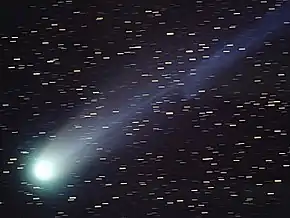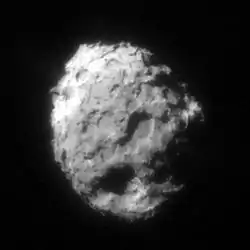Comet Bennett
Comet Bennett, formally known as C/1969 Y1 (old style 1970 II and 1969i), was one of two brilliant comets to grace earth in the 1970s, along with Comet West. The name is also borne by an altogether different comet, C/1974 V2. Discovered by John Caister Bennett on December 28, 1969 while still almost two AUs from the Sun, it reached perihelion on March 20, passing closest to Earth on March 26, 1970 as it receded, peaking at magnitude 0.[1] It was last observed on February 27, 1971.[1] Comet Bennett was intended to be photographed by the crew of Apollo 13 during their journey to the Moon. Their first attempt on April 13, 1970 was unsuccessful. On April 14, 1970, after completing the manoeuvre to orient the spacecraft for a second attempt, Odyssey's service module ruptured, forcing the cancellation of the mission's nominal scientific objectives.[2][3]
 | |
| Discovery | |
|---|---|
| Discovered by | John Caister Bennett |
| Discovery date | 1969 |
| Alternative designations | Comet Bennett, 1969 Y1 |
| Orbital characteristics A | |
| Epoch | 2440680.5 (April 4, 1970) |
| Aphelion | 282 AU |
| Perihelion | 0.538 AU |
| Semi-major axis | 141 AU |
| Eccentricity | 0.9962 |
| Orbital period | 1678 a |
| Inclination | 90.0° |
| Last perihelion | March 20, 1970 |
| Next perihelion | 3600s |
References
- C&MS: C/1969 Y1 (Bennett)
- "Apollo Expeditions to the Moon: Chapter 13". history.nasa.gov. Retrieved 2015-06-05.
- Apollo 13 Accident – Flight Director Loop Part 1, retrieved 2015-06-05

